CMM92001-2019-2: Risk and Resilience Engineering Safety Case Report
VerifiedAdded on 2022/10/11
|11
|3572
|7
Report
AI Summary
This safety case report, prepared for the CMM92001-2019-2 Risk and Resilience Engineering Assessment, provides a detailed analysis of various risks within the engineering field. The report categorizes risks into electrical, mechanical, construction, physical security, site security, governmental manipulation, human engineering, and financial risks. It explores the hazards associated with each category, such as the use of substandard materials in electrical systems, diesel system failures in mechanical systems, scaffolding collapses in construction, and security breaches. The report also delves into governmental manipulation, human engineering, and financial risks. The report provides mitigation strategies for each risk, emphasizing the importance of high-quality materials, proper maintenance, security measures, and adherence to design norms. The report concludes with recommendations for minimizing risks and ensuring safety, and references relevant literature to support its findings. The report is a comprehensive overview of risk assessment and mitigation in engineering projects.
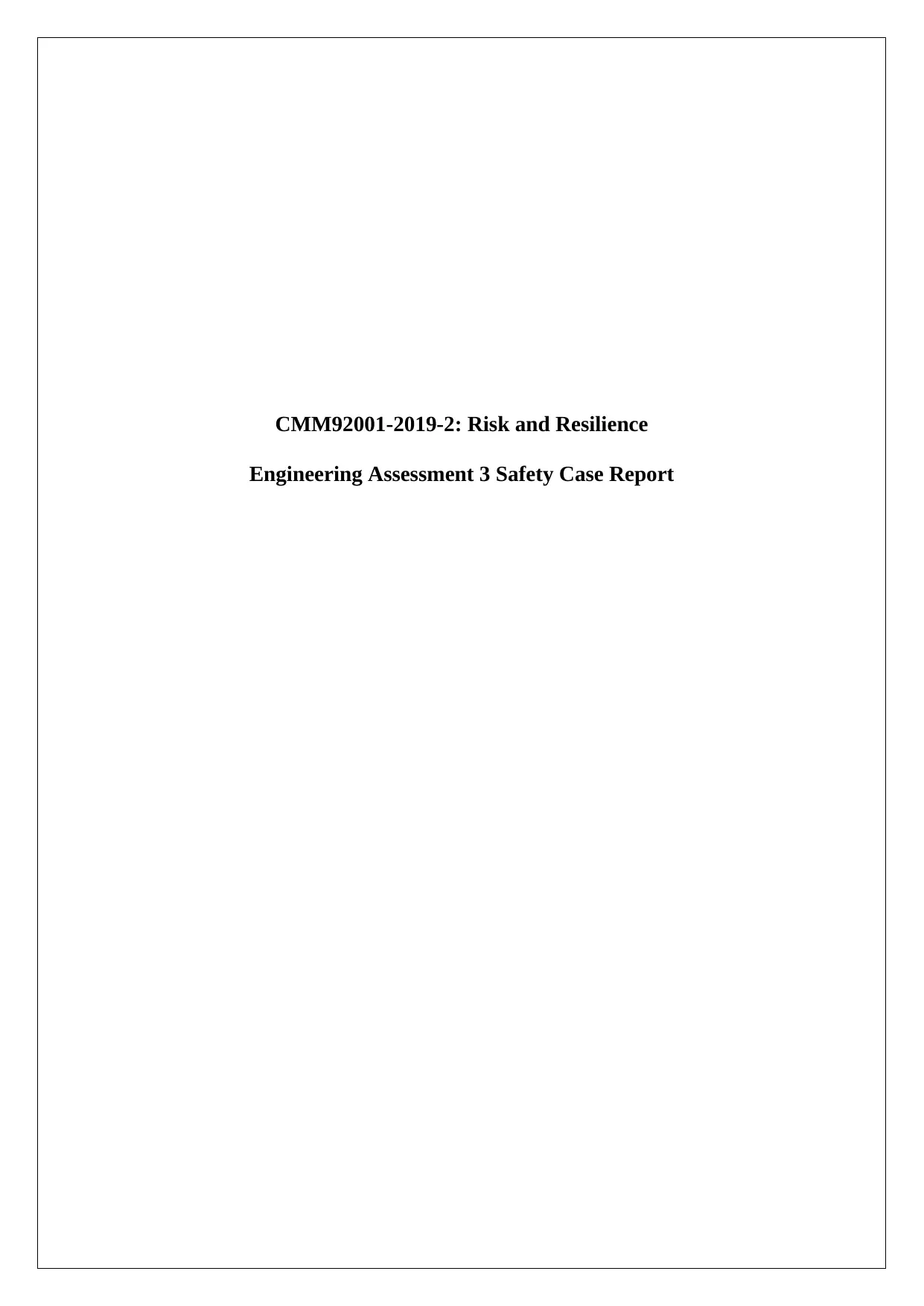
CMM92001-2019-2: Risk and Resilience
Engineering Assessment 3 Safety Case Report
Engineering Assessment 3 Safety Case Report
Paraphrase This Document
Need a fresh take? Get an instant paraphrase of this document with our AI Paraphraser
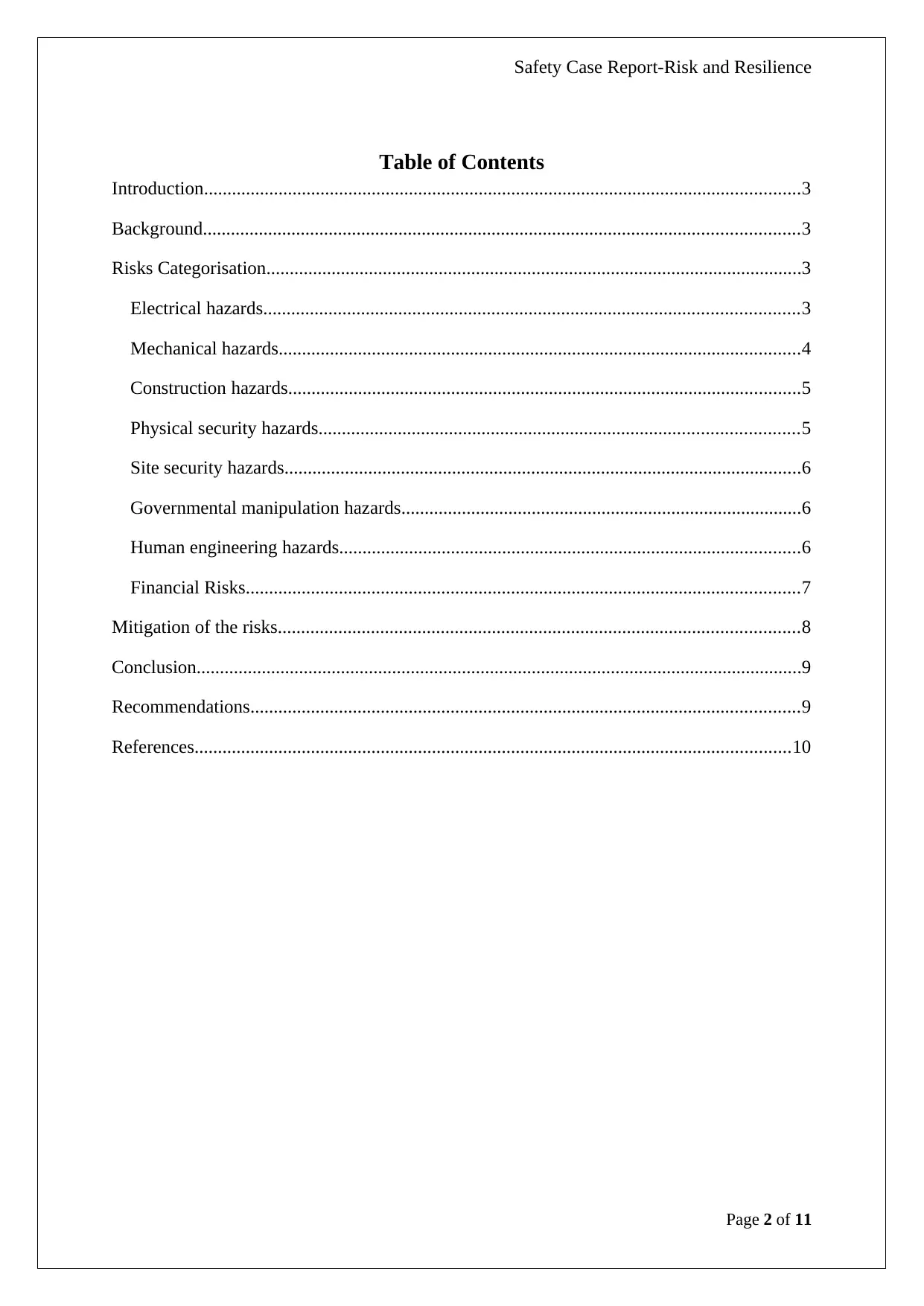
Safety Case Report-Risk and Resilience
Table of Contents
Introduction................................................................................................................................3
Background................................................................................................................................3
Risks Categorisation...................................................................................................................3
Electrical hazards...................................................................................................................3
Mechanical hazards................................................................................................................4
Construction hazards..............................................................................................................5
Physical security hazards.......................................................................................................5
Site security hazards...............................................................................................................6
Governmental manipulation hazards......................................................................................6
Human engineering hazards...................................................................................................6
Financial Risks.......................................................................................................................7
Mitigation of the risks................................................................................................................8
Conclusion..................................................................................................................................9
Recommendations......................................................................................................................9
References................................................................................................................................10
Page 2 of 11
Table of Contents
Introduction................................................................................................................................3
Background................................................................................................................................3
Risks Categorisation...................................................................................................................3
Electrical hazards...................................................................................................................3
Mechanical hazards................................................................................................................4
Construction hazards..............................................................................................................5
Physical security hazards.......................................................................................................5
Site security hazards...............................................................................................................6
Governmental manipulation hazards......................................................................................6
Human engineering hazards...................................................................................................6
Financial Risks.......................................................................................................................7
Mitigation of the risks................................................................................................................8
Conclusion..................................................................................................................................9
Recommendations......................................................................................................................9
References................................................................................................................................10
Page 2 of 11
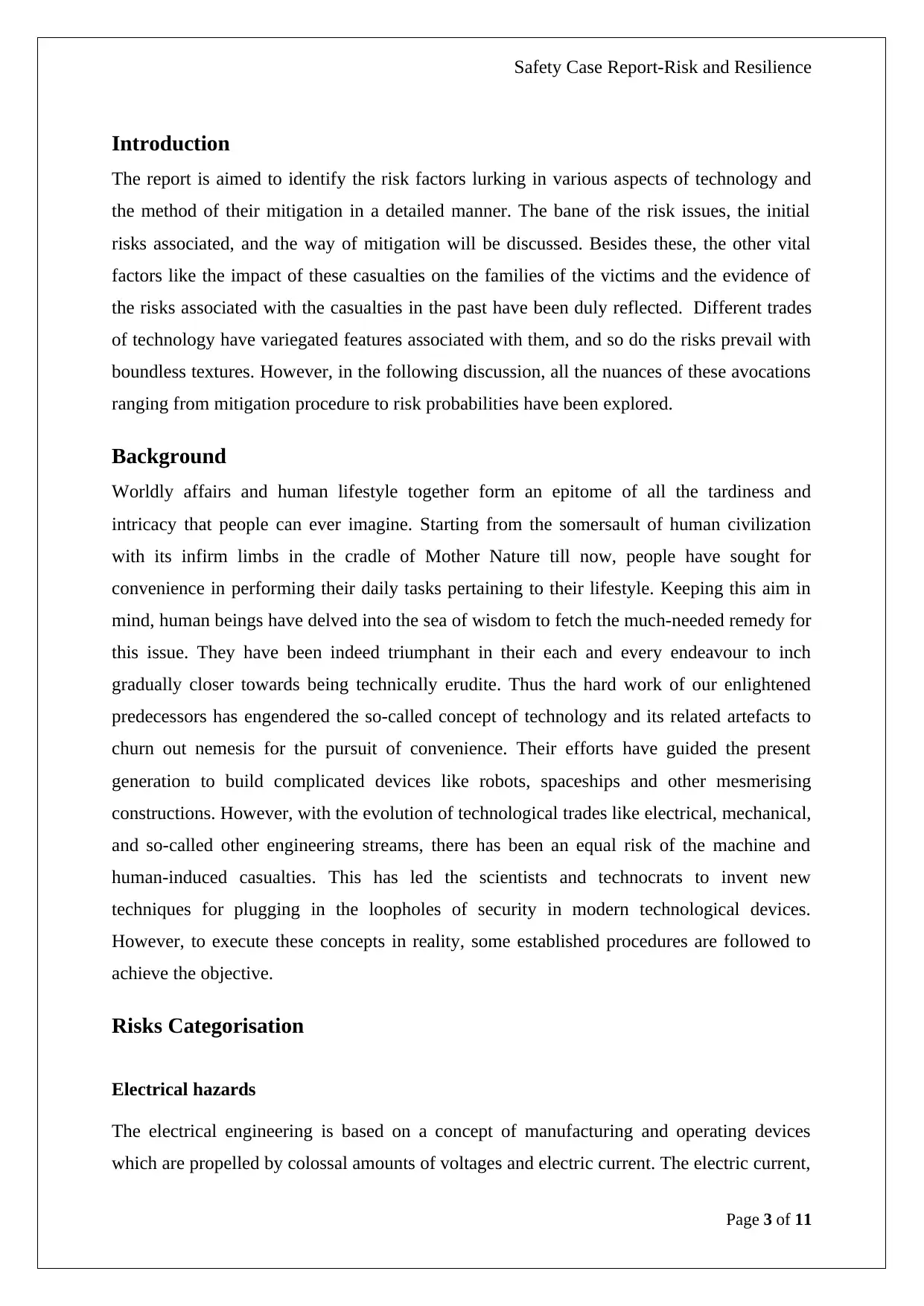
Safety Case Report-Risk and Resilience
Introduction
The report is aimed to identify the risk factors lurking in various aspects of technology and
the method of their mitigation in a detailed manner. The bane of the risk issues, the initial
risks associated, and the way of mitigation will be discussed. Besides these, the other vital
factors like the impact of these casualties on the families of the victims and the evidence of
the risks associated with the casualties in the past have been duly reflected. Different trades
of technology have variegated features associated with them, and so do the risks prevail with
boundless textures. However, in the following discussion, all the nuances of these avocations
ranging from mitigation procedure to risk probabilities have been explored.
Background
Worldly affairs and human lifestyle together form an epitome of all the tardiness and
intricacy that people can ever imagine. Starting from the somersault of human civilization
with its infirm limbs in the cradle of Mother Nature till now, people have sought for
convenience in performing their daily tasks pertaining to their lifestyle. Keeping this aim in
mind, human beings have delved into the sea of wisdom to fetch the much-needed remedy for
this issue. They have been indeed triumphant in their each and every endeavour to inch
gradually closer towards being technically erudite. Thus the hard work of our enlightened
predecessors has engendered the so-called concept of technology and its related artefacts to
churn out nemesis for the pursuit of convenience. Their efforts have guided the present
generation to build complicated devices like robots, spaceships and other mesmerising
constructions. However, with the evolution of technological trades like electrical, mechanical,
and so-called other engineering streams, there has been an equal risk of the machine and
human-induced casualties. This has led the scientists and technocrats to invent new
techniques for plugging in the loopholes of security in modern technological devices.
However, to execute these concepts in reality, some established procedures are followed to
achieve the objective.
Risks Categorisation
Electrical hazards
The electrical engineering is based on a concept of manufacturing and operating devices
which are propelled by colossal amounts of voltages and electric current. The electric current,
Page 3 of 11
Introduction
The report is aimed to identify the risk factors lurking in various aspects of technology and
the method of their mitigation in a detailed manner. The bane of the risk issues, the initial
risks associated, and the way of mitigation will be discussed. Besides these, the other vital
factors like the impact of these casualties on the families of the victims and the evidence of
the risks associated with the casualties in the past have been duly reflected. Different trades
of technology have variegated features associated with them, and so do the risks prevail with
boundless textures. However, in the following discussion, all the nuances of these avocations
ranging from mitigation procedure to risk probabilities have been explored.
Background
Worldly affairs and human lifestyle together form an epitome of all the tardiness and
intricacy that people can ever imagine. Starting from the somersault of human civilization
with its infirm limbs in the cradle of Mother Nature till now, people have sought for
convenience in performing their daily tasks pertaining to their lifestyle. Keeping this aim in
mind, human beings have delved into the sea of wisdom to fetch the much-needed remedy for
this issue. They have been indeed triumphant in their each and every endeavour to inch
gradually closer towards being technically erudite. Thus the hard work of our enlightened
predecessors has engendered the so-called concept of technology and its related artefacts to
churn out nemesis for the pursuit of convenience. Their efforts have guided the present
generation to build complicated devices like robots, spaceships and other mesmerising
constructions. However, with the evolution of technological trades like electrical, mechanical,
and so-called other engineering streams, there has been an equal risk of the machine and
human-induced casualties. This has led the scientists and technocrats to invent new
techniques for plugging in the loopholes of security in modern technological devices.
However, to execute these concepts in reality, some established procedures are followed to
achieve the objective.
Risks Categorisation
Electrical hazards
The electrical engineering is based on a concept of manufacturing and operating devices
which are propelled by colossal amounts of voltages and electric current. The electric current,
Page 3 of 11
⊘ This is a preview!⊘
Do you want full access?
Subscribe today to unlock all pages.

Trusted by 1+ million students worldwide
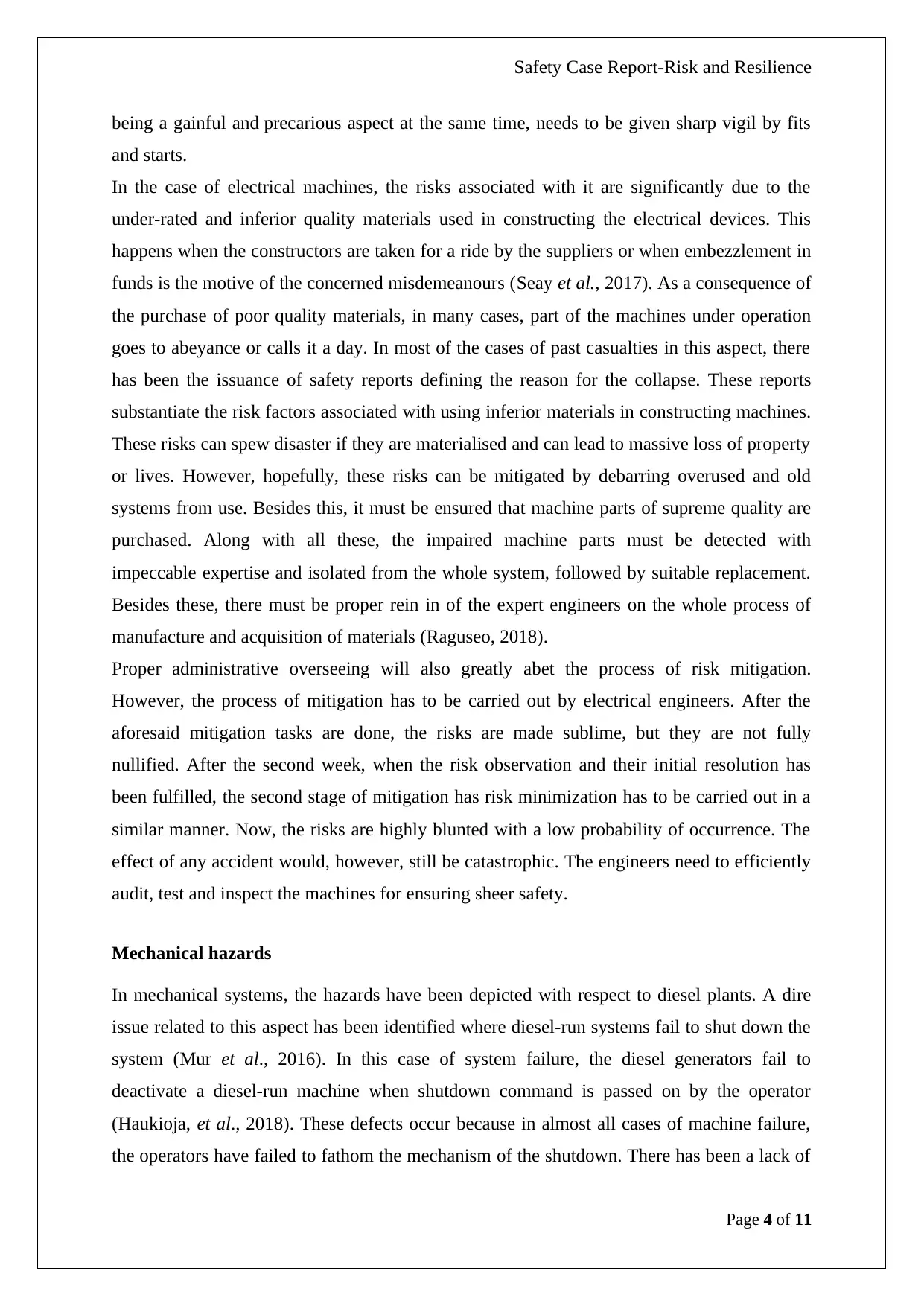
Safety Case Report-Risk and Resilience
being a gainful and precarious aspect at the same time, needs to be given sharp vigil by fits
and starts.
In the case of electrical machines, the risks associated with it are significantly due to the
under-rated and inferior quality materials used in constructing the electrical devices. This
happens when the constructors are taken for a ride by the suppliers or when embezzlement in
funds is the motive of the concerned misdemeanours (Seay et al., 2017). As a consequence of
the purchase of poor quality materials, in many cases, part of the machines under operation
goes to abeyance or calls it a day. In most of the cases of past casualties in this aspect, there
has been the issuance of safety reports defining the reason for the collapse. These reports
substantiate the risk factors associated with using inferior materials in constructing machines.
These risks can spew disaster if they are materialised and can lead to massive loss of property
or lives. However, hopefully, these risks can be mitigated by debarring overused and old
systems from use. Besides this, it must be ensured that machine parts of supreme quality are
purchased. Along with all these, the impaired machine parts must be detected with
impeccable expertise and isolated from the whole system, followed by suitable replacement.
Besides these, there must be proper rein in of the expert engineers on the whole process of
manufacture and acquisition of materials (Raguseo, 2018).
Proper administrative overseeing will also greatly abet the process of risk mitigation.
However, the process of mitigation has to be carried out by electrical engineers. After the
aforesaid mitigation tasks are done, the risks are made sublime, but they are not fully
nullified. After the second week, when the risk observation and their initial resolution has
been fulfilled, the second stage of mitigation has risk minimization has to be carried out in a
similar manner. Now, the risks are highly blunted with a low probability of occurrence. The
effect of any accident would, however, still be catastrophic. The engineers need to efficiently
audit, test and inspect the machines for ensuring sheer safety.
Mechanical hazards
In mechanical systems, the hazards have been depicted with respect to diesel plants. A dire
issue related to this aspect has been identified where diesel-run systems fail to shut down the
system (Mur et al., 2016). In this case of system failure, the diesel generators fail to
deactivate a diesel-run machine when shutdown command is passed on by the operator
(Haukioja, et al., 2018). These defects occur because in almost all cases of machine failure,
the operators have failed to fathom the mechanism of the shutdown. There has been a lack of
Page 4 of 11
being a gainful and precarious aspect at the same time, needs to be given sharp vigil by fits
and starts.
In the case of electrical machines, the risks associated with it are significantly due to the
under-rated and inferior quality materials used in constructing the electrical devices. This
happens when the constructors are taken for a ride by the suppliers or when embezzlement in
funds is the motive of the concerned misdemeanours (Seay et al., 2017). As a consequence of
the purchase of poor quality materials, in many cases, part of the machines under operation
goes to abeyance or calls it a day. In most of the cases of past casualties in this aspect, there
has been the issuance of safety reports defining the reason for the collapse. These reports
substantiate the risk factors associated with using inferior materials in constructing machines.
These risks can spew disaster if they are materialised and can lead to massive loss of property
or lives. However, hopefully, these risks can be mitigated by debarring overused and old
systems from use. Besides this, it must be ensured that machine parts of supreme quality are
purchased. Along with all these, the impaired machine parts must be detected with
impeccable expertise and isolated from the whole system, followed by suitable replacement.
Besides these, there must be proper rein in of the expert engineers on the whole process of
manufacture and acquisition of materials (Raguseo, 2018).
Proper administrative overseeing will also greatly abet the process of risk mitigation.
However, the process of mitigation has to be carried out by electrical engineers. After the
aforesaid mitigation tasks are done, the risks are made sublime, but they are not fully
nullified. After the second week, when the risk observation and their initial resolution has
been fulfilled, the second stage of mitigation has risk minimization has to be carried out in a
similar manner. Now, the risks are highly blunted with a low probability of occurrence. The
effect of any accident would, however, still be catastrophic. The engineers need to efficiently
audit, test and inspect the machines for ensuring sheer safety.
Mechanical hazards
In mechanical systems, the hazards have been depicted with respect to diesel plants. A dire
issue related to this aspect has been identified where diesel-run systems fail to shut down the
system (Mur et al., 2016). In this case of system failure, the diesel generators fail to
deactivate a diesel-run machine when shutdown command is passed on by the operator
(Haukioja, et al., 2018). These defects occur because in almost all cases of machine failure,
the operators have failed to fathom the mechanism of the shutdown. There has been a lack of
Page 4 of 11
Paraphrase This Document
Need a fresh take? Get an instant paraphrase of this document with our AI Paraphraser
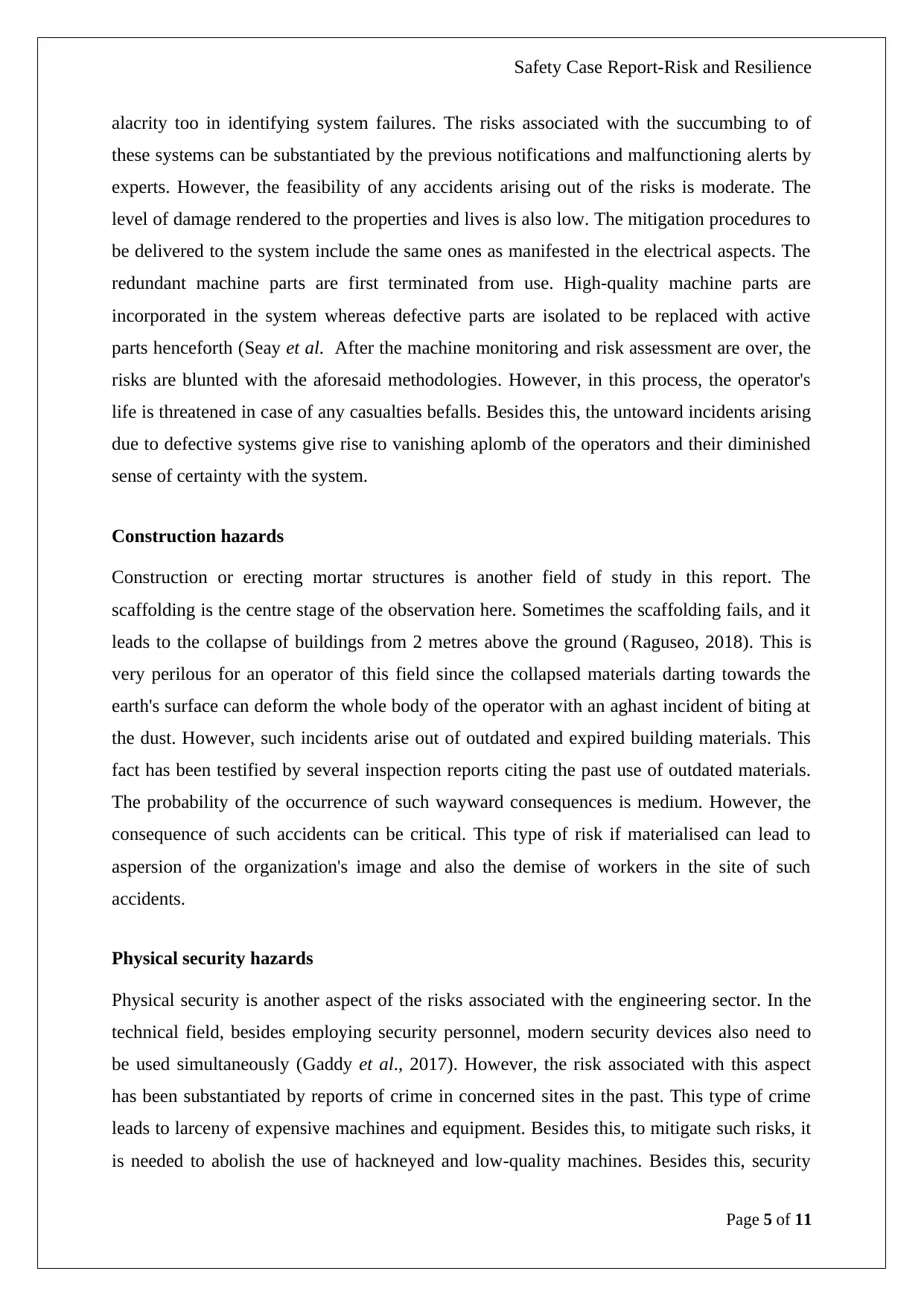
Safety Case Report-Risk and Resilience
alacrity too in identifying system failures. The risks associated with the succumbing to of
these systems can be substantiated by the previous notifications and malfunctioning alerts by
experts. However, the feasibility of any accidents arising out of the risks is moderate. The
level of damage rendered to the properties and lives is also low. The mitigation procedures to
be delivered to the system include the same ones as manifested in the electrical aspects. The
redundant machine parts are first terminated from use. High-quality machine parts are
incorporated in the system whereas defective parts are isolated to be replaced with active
parts henceforth (Seay et al. After the machine monitoring and risk assessment are over, the
risks are blunted with the aforesaid methodologies. However, in this process, the operator's
life is threatened in case of any casualties befalls. Besides this, the untoward incidents arising
due to defective systems give rise to vanishing aplomb of the operators and their diminished
sense of certainty with the system.
Construction hazards
Construction or erecting mortar structures is another field of study in this report. The
scaffolding is the centre stage of the observation here. Sometimes the scaffolding fails, and it
leads to the collapse of buildings from 2 metres above the ground (Raguseo, 2018). This is
very perilous for an operator of this field since the collapsed materials darting towards the
earth's surface can deform the whole body of the operator with an aghast incident of biting at
the dust. However, such incidents arise out of outdated and expired building materials. This
fact has been testified by several inspection reports citing the past use of outdated materials.
The probability of the occurrence of such wayward consequences is medium. However, the
consequence of such accidents can be critical. This type of risk if materialised can lead to
aspersion of the organization's image and also the demise of workers in the site of such
accidents.
Physical security hazards
Physical security is another aspect of the risks associated with the engineering sector. In the
technical field, besides employing security personnel, modern security devices also need to
be used simultaneously (Gaddy et al., 2017). However, the risk associated with this aspect
has been substantiated by reports of crime in concerned sites in the past. This type of crime
leads to larceny of expensive machines and equipment. Besides this, to mitigate such risks, it
is needed to abolish the use of hackneyed and low-quality machines. Besides this, security
Page 5 of 11
alacrity too in identifying system failures. The risks associated with the succumbing to of
these systems can be substantiated by the previous notifications and malfunctioning alerts by
experts. However, the feasibility of any accidents arising out of the risks is moderate. The
level of damage rendered to the properties and lives is also low. The mitigation procedures to
be delivered to the system include the same ones as manifested in the electrical aspects. The
redundant machine parts are first terminated from use. High-quality machine parts are
incorporated in the system whereas defective parts are isolated to be replaced with active
parts henceforth (Seay et al. After the machine monitoring and risk assessment are over, the
risks are blunted with the aforesaid methodologies. However, in this process, the operator's
life is threatened in case of any casualties befalls. Besides this, the untoward incidents arising
due to defective systems give rise to vanishing aplomb of the operators and their diminished
sense of certainty with the system.
Construction hazards
Construction or erecting mortar structures is another field of study in this report. The
scaffolding is the centre stage of the observation here. Sometimes the scaffolding fails, and it
leads to the collapse of buildings from 2 metres above the ground (Raguseo, 2018). This is
very perilous for an operator of this field since the collapsed materials darting towards the
earth's surface can deform the whole body of the operator with an aghast incident of biting at
the dust. However, such incidents arise out of outdated and expired building materials. This
fact has been testified by several inspection reports citing the past use of outdated materials.
The probability of the occurrence of such wayward consequences is medium. However, the
consequence of such accidents can be critical. This type of risk if materialised can lead to
aspersion of the organization's image and also the demise of workers in the site of such
accidents.
Physical security hazards
Physical security is another aspect of the risks associated with the engineering sector. In the
technical field, besides employing security personnel, modern security devices also need to
be used simultaneously (Gaddy et al., 2017). However, the risk associated with this aspect
has been substantiated by reports of crime in concerned sites in the past. This type of crime
leads to larceny of expensive machines and equipment. Besides this, to mitigate such risks, it
is needed to abolish the use of hackneyed and low-quality machines. Besides this, security
Page 5 of 11
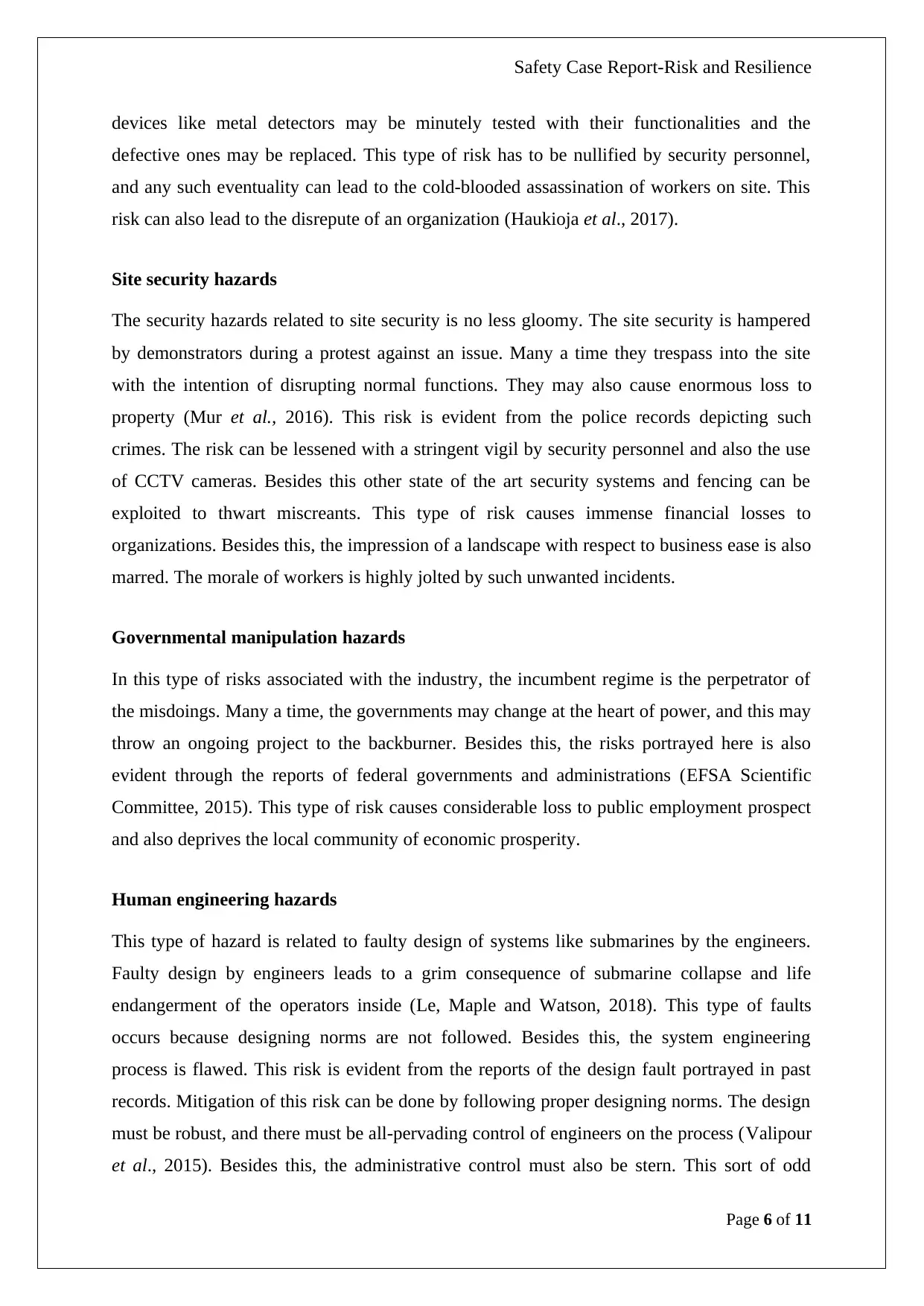
Safety Case Report-Risk and Resilience
devices like metal detectors may be minutely tested with their functionalities and the
defective ones may be replaced. This type of risk has to be nullified by security personnel,
and any such eventuality can lead to the cold-blooded assassination of workers on site. This
risk can also lead to the disrepute of an organization (Haukioja et al., 2017).
Site security hazards
The security hazards related to site security is no less gloomy. The site security is hampered
by demonstrators during a protest against an issue. Many a time they trespass into the site
with the intention of disrupting normal functions. They may also cause enormous loss to
property (Mur et al., 2016). This risk is evident from the police records depicting such
crimes. The risk can be lessened with a stringent vigil by security personnel and also the use
of CCTV cameras. Besides this other state of the art security systems and fencing can be
exploited to thwart miscreants. This type of risk causes immense financial losses to
organizations. Besides this, the impression of a landscape with respect to business ease is also
marred. The morale of workers is highly jolted by such unwanted incidents.
Governmental manipulation hazards
In this type of risks associated with the industry, the incumbent regime is the perpetrator of
the misdoings. Many a time, the governments may change at the heart of power, and this may
throw an ongoing project to the backburner. Besides this, the risks portrayed here is also
evident through the reports of federal governments and administrations (EFSA Scientific
Committee, 2015). This type of risk causes considerable loss to public employment prospect
and also deprives the local community of economic prosperity.
Human engineering hazards
This type of hazard is related to faulty design of systems like submarines by the engineers.
Faulty design by engineers leads to a grim consequence of submarine collapse and life
endangerment of the operators inside (Le, Maple and Watson, 2018). This type of faults
occurs because designing norms are not followed. Besides this, the system engineering
process is flawed. This risk is evident from the reports of the design fault portrayed in past
records. Mitigation of this risk can be done by following proper designing norms. The design
must be robust, and there must be all-pervading control of engineers on the process (Valipour
et al., 2015). Besides this, the administrative control must also be stern. This sort of odd
Page 6 of 11
devices like metal detectors may be minutely tested with their functionalities and the
defective ones may be replaced. This type of risk has to be nullified by security personnel,
and any such eventuality can lead to the cold-blooded assassination of workers on site. This
risk can also lead to the disrepute of an organization (Haukioja et al., 2017).
Site security hazards
The security hazards related to site security is no less gloomy. The site security is hampered
by demonstrators during a protest against an issue. Many a time they trespass into the site
with the intention of disrupting normal functions. They may also cause enormous loss to
property (Mur et al., 2016). This risk is evident from the police records depicting such
crimes. The risk can be lessened with a stringent vigil by security personnel and also the use
of CCTV cameras. Besides this other state of the art security systems and fencing can be
exploited to thwart miscreants. This type of risk causes immense financial losses to
organizations. Besides this, the impression of a landscape with respect to business ease is also
marred. The morale of workers is highly jolted by such unwanted incidents.
Governmental manipulation hazards
In this type of risks associated with the industry, the incumbent regime is the perpetrator of
the misdoings. Many a time, the governments may change at the heart of power, and this may
throw an ongoing project to the backburner. Besides this, the risks portrayed here is also
evident through the reports of federal governments and administrations (EFSA Scientific
Committee, 2015). This type of risk causes considerable loss to public employment prospect
and also deprives the local community of economic prosperity.
Human engineering hazards
This type of hazard is related to faulty design of systems like submarines by the engineers.
Faulty design by engineers leads to a grim consequence of submarine collapse and life
endangerment of the operators inside (Le, Maple and Watson, 2018). This type of faults
occurs because designing norms are not followed. Besides this, the system engineering
process is flawed. This risk is evident from the reports of the design fault portrayed in past
records. Mitigation of this risk can be done by following proper designing norms. The design
must be robust, and there must be all-pervading control of engineers on the process (Valipour
et al., 2015). Besides this, the administrative control must also be stern. This sort of odd
Page 6 of 11
⊘ This is a preview!⊘
Do you want full access?
Subscribe today to unlock all pages.

Trusted by 1+ million students worldwide
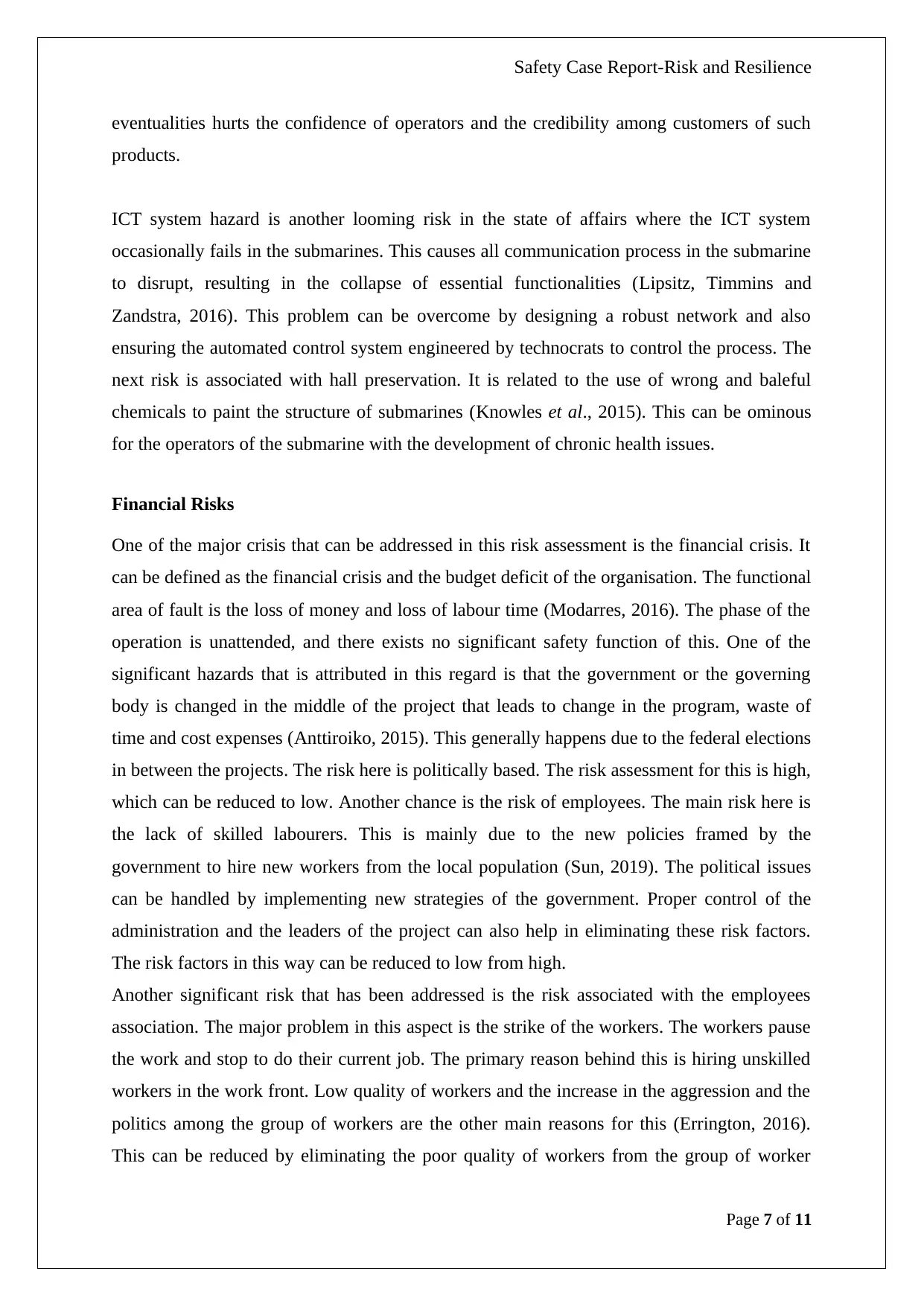
Safety Case Report-Risk and Resilience
eventualities hurts the confidence of operators and the credibility among customers of such
products.
ICT system hazard is another looming risk in the state of affairs where the ICT system
occasionally fails in the submarines. This causes all communication process in the submarine
to disrupt, resulting in the collapse of essential functionalities (Lipsitz, Timmins and
Zandstra, 2016). This problem can be overcome by designing a robust network and also
ensuring the automated control system engineered by technocrats to control the process. The
next risk is associated with hall preservation. It is related to the use of wrong and baleful
chemicals to paint the structure of submarines (Knowles et al., 2015). This can be ominous
for the operators of the submarine with the development of chronic health issues.
Financial Risks
One of the major crisis that can be addressed in this risk assessment is the financial crisis. It
can be defined as the financial crisis and the budget deficit of the organisation. The functional
area of fault is the loss of money and loss of labour time (Modarres, 2016). The phase of the
operation is unattended, and there exists no significant safety function of this. One of the
significant hazards that is attributed in this regard is that the government or the governing
body is changed in the middle of the project that leads to change in the program, waste of
time and cost expenses (Anttiroiko, 2015). This generally happens due to the federal elections
in between the projects. The risk here is politically based. The risk assessment for this is high,
which can be reduced to low. Another chance is the risk of employees. The main risk here is
the lack of skilled labourers. This is mainly due to the new policies framed by the
government to hire new workers from the local population (Sun, 2019). The political issues
can be handled by implementing new strategies of the government. Proper control of the
administration and the leaders of the project can also help in eliminating these risk factors.
The risk factors in this way can be reduced to low from high.
Another significant risk that has been addressed is the risk associated with the employees
association. The major problem in this aspect is the strike of the workers. The workers pause
the work and stop to do their current job. The primary reason behind this is hiring unskilled
workers in the work front. Low quality of workers and the increase in the aggression and the
politics among the group of workers are the other main reasons for this (Errington, 2016).
This can be reduced by eliminating the poor quality of workers from the group of worker
Page 7 of 11
eventualities hurts the confidence of operators and the credibility among customers of such
products.
ICT system hazard is another looming risk in the state of affairs where the ICT system
occasionally fails in the submarines. This causes all communication process in the submarine
to disrupt, resulting in the collapse of essential functionalities (Lipsitz, Timmins and
Zandstra, 2016). This problem can be overcome by designing a robust network and also
ensuring the automated control system engineered by technocrats to control the process. The
next risk is associated with hall preservation. It is related to the use of wrong and baleful
chemicals to paint the structure of submarines (Knowles et al., 2015). This can be ominous
for the operators of the submarine with the development of chronic health issues.
Financial Risks
One of the major crisis that can be addressed in this risk assessment is the financial crisis. It
can be defined as the financial crisis and the budget deficit of the organisation. The functional
area of fault is the loss of money and loss of labour time (Modarres, 2016). The phase of the
operation is unattended, and there exists no significant safety function of this. One of the
significant hazards that is attributed in this regard is that the government or the governing
body is changed in the middle of the project that leads to change in the program, waste of
time and cost expenses (Anttiroiko, 2015). This generally happens due to the federal elections
in between the projects. The risk here is politically based. The risk assessment for this is high,
which can be reduced to low. Another chance is the risk of employees. The main risk here is
the lack of skilled labourers. This is mainly due to the new policies framed by the
government to hire new workers from the local population (Sun, 2019). The political issues
can be handled by implementing new strategies of the government. Proper control of the
administration and the leaders of the project can also help in eliminating these risk factors.
The risk factors in this way can be reduced to low from high.
Another significant risk that has been addressed is the risk associated with the employees
association. The major problem in this aspect is the strike of the workers. The workers pause
the work and stop to do their current job. The primary reason behind this is hiring unskilled
workers in the work front. Low quality of workers and the increase in the aggression and the
politics among the group of workers are the other main reasons for this (Errington, 2016).
This can be reduced by eliminating the poor quality of workers from the group of worker
Page 7 of 11
Paraphrase This Document
Need a fresh take? Get an instant paraphrase of this document with our AI Paraphraser
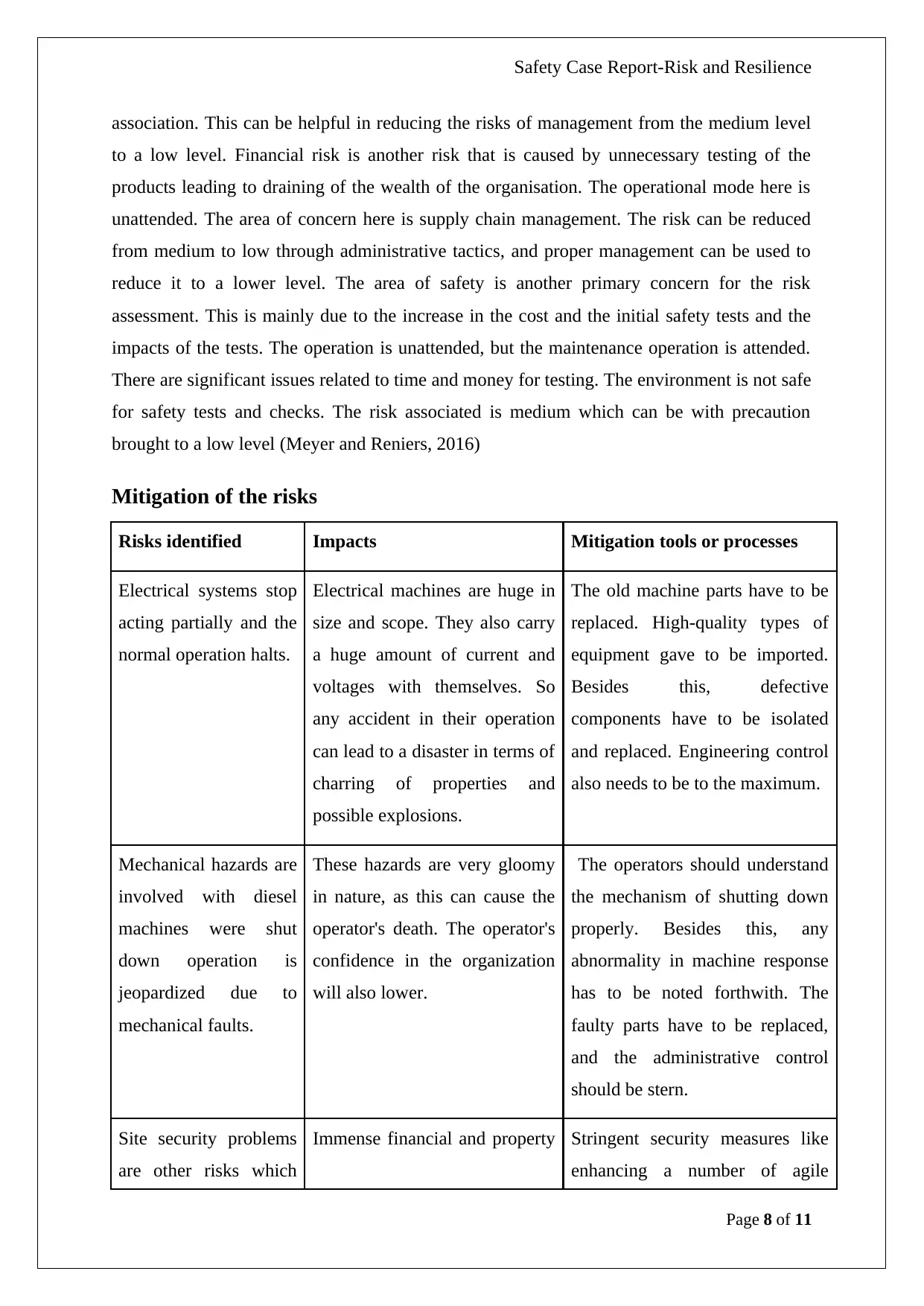
Safety Case Report-Risk and Resilience
association. This can be helpful in reducing the risks of management from the medium level
to a low level. Financial risk is another risk that is caused by unnecessary testing of the
products leading to draining of the wealth of the organisation. The operational mode here is
unattended. The area of concern here is supply chain management. The risk can be reduced
from medium to low through administrative tactics, and proper management can be used to
reduce it to a lower level. The area of safety is another primary concern for the risk
assessment. This is mainly due to the increase in the cost and the initial safety tests and the
impacts of the tests. The operation is unattended, but the maintenance operation is attended.
There are significant issues related to time and money for testing. The environment is not safe
for safety tests and checks. The risk associated is medium which can be with precaution
brought to a low level (Meyer and Reniers, 2016)
Mitigation of the risks
Risks identified Impacts Mitigation tools or processes
Electrical systems stop
acting partially and the
normal operation halts.
Electrical machines are huge in
size and scope. They also carry
a huge amount of current and
voltages with themselves. So
any accident in their operation
can lead to a disaster in terms of
charring of properties and
possible explosions.
The old machine parts have to be
replaced. High-quality types of
equipment gave to be imported.
Besides this, defective
components have to be isolated
and replaced. Engineering control
also needs to be to the maximum.
Mechanical hazards are
involved with diesel
machines were shut
down operation is
jeopardized due to
mechanical faults.
These hazards are very gloomy
in nature, as this can cause the
operator's death. The operator's
confidence in the organization
will also lower.
The operators should understand
the mechanism of shutting down
properly. Besides this, any
abnormality in machine response
has to be noted forthwith. The
faulty parts have to be replaced,
and the administrative control
should be stern.
Site security problems
are other risks which
Immense financial and property Stringent security measures like
enhancing a number of agile
Page 8 of 11
association. This can be helpful in reducing the risks of management from the medium level
to a low level. Financial risk is another risk that is caused by unnecessary testing of the
products leading to draining of the wealth of the organisation. The operational mode here is
unattended. The area of concern here is supply chain management. The risk can be reduced
from medium to low through administrative tactics, and proper management can be used to
reduce it to a lower level. The area of safety is another primary concern for the risk
assessment. This is mainly due to the increase in the cost and the initial safety tests and the
impacts of the tests. The operation is unattended, but the maintenance operation is attended.
There are significant issues related to time and money for testing. The environment is not safe
for safety tests and checks. The risk associated is medium which can be with precaution
brought to a low level (Meyer and Reniers, 2016)
Mitigation of the risks
Risks identified Impacts Mitigation tools or processes
Electrical systems stop
acting partially and the
normal operation halts.
Electrical machines are huge in
size and scope. They also carry
a huge amount of current and
voltages with themselves. So
any accident in their operation
can lead to a disaster in terms of
charring of properties and
possible explosions.
The old machine parts have to be
replaced. High-quality types of
equipment gave to be imported.
Besides this, defective
components have to be isolated
and replaced. Engineering control
also needs to be to the maximum.
Mechanical hazards are
involved with diesel
machines were shut
down operation is
jeopardized due to
mechanical faults.
These hazards are very gloomy
in nature, as this can cause the
operator's death. The operator's
confidence in the organization
will also lower.
The operators should understand
the mechanism of shutting down
properly. Besides this, any
abnormality in machine response
has to be noted forthwith. The
faulty parts have to be replaced,
and the administrative control
should be stern.
Site security problems
are other risks which
Immense financial and property Stringent security measures like
enhancing a number of agile
Page 8 of 11
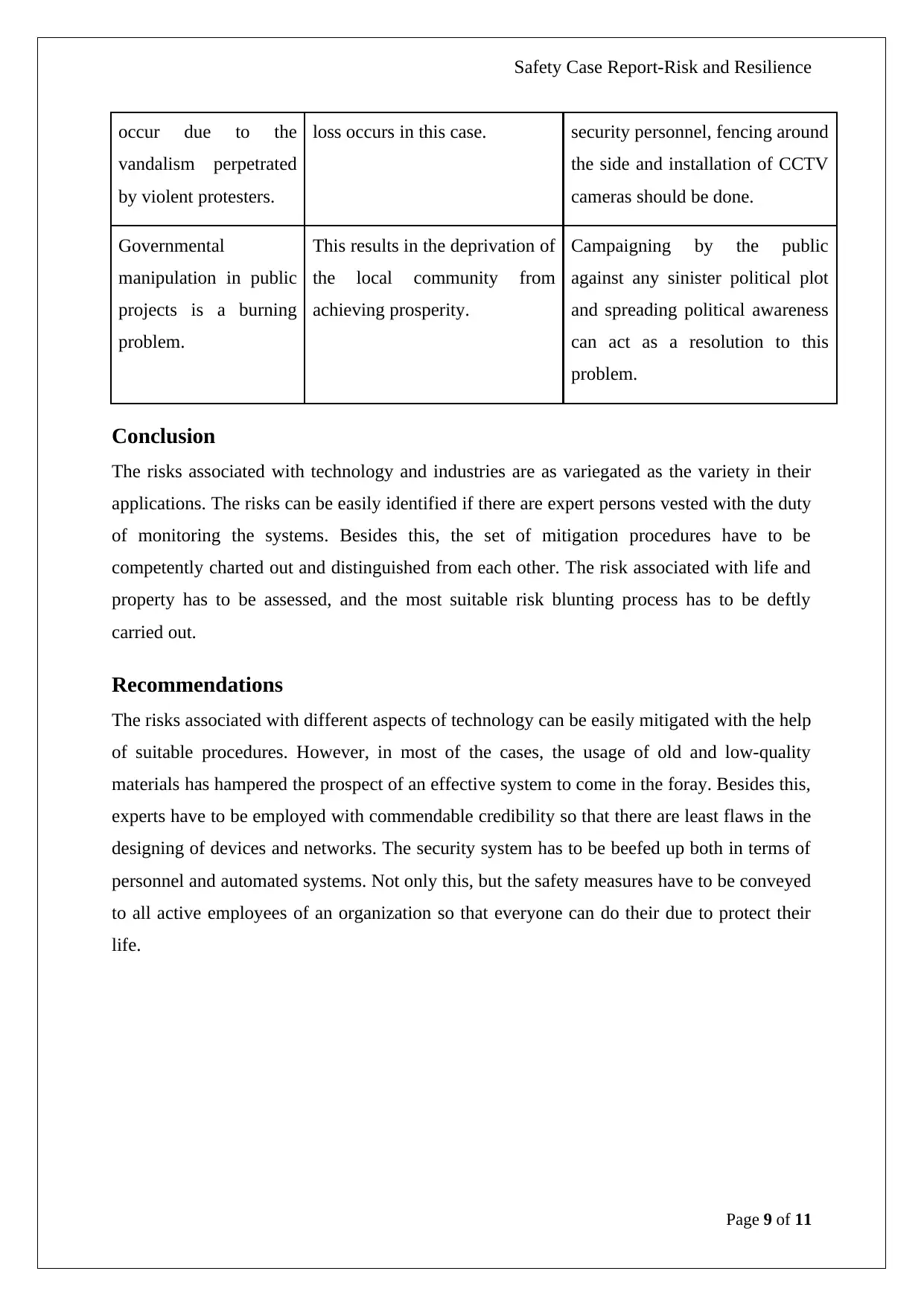
Safety Case Report-Risk and Resilience
occur due to the
vandalism perpetrated
by violent protesters.
loss occurs in this case. security personnel, fencing around
the side and installation of CCTV
cameras should be done.
Governmental
manipulation in public
projects is a burning
problem.
This results in the deprivation of
the local community from
achieving prosperity.
Campaigning by the public
against any sinister political plot
and spreading political awareness
can act as a resolution to this
problem.
Conclusion
The risks associated with technology and industries are as variegated as the variety in their
applications. The risks can be easily identified if there are expert persons vested with the duty
of monitoring the systems. Besides this, the set of mitigation procedures have to be
competently charted out and distinguished from each other. The risk associated with life and
property has to be assessed, and the most suitable risk blunting process has to be deftly
carried out.
Recommendations
The risks associated with different aspects of technology can be easily mitigated with the help
of suitable procedures. However, in most of the cases, the usage of old and low-quality
materials has hampered the prospect of an effective system to come in the foray. Besides this,
experts have to be employed with commendable credibility so that there are least flaws in the
designing of devices and networks. The security system has to be beefed up both in terms of
personnel and automated systems. Not only this, but the safety measures have to be conveyed
to all active employees of an organization so that everyone can do their due to protect their
life.
Page 9 of 11
occur due to the
vandalism perpetrated
by violent protesters.
loss occurs in this case. security personnel, fencing around
the side and installation of CCTV
cameras should be done.
Governmental
manipulation in public
projects is a burning
problem.
This results in the deprivation of
the local community from
achieving prosperity.
Campaigning by the public
against any sinister political plot
and spreading political awareness
can act as a resolution to this
problem.
Conclusion
The risks associated with technology and industries are as variegated as the variety in their
applications. The risks can be easily identified if there are expert persons vested with the duty
of monitoring the systems. Besides this, the set of mitigation procedures have to be
competently charted out and distinguished from each other. The risk associated with life and
property has to be assessed, and the most suitable risk blunting process has to be deftly
carried out.
Recommendations
The risks associated with different aspects of technology can be easily mitigated with the help
of suitable procedures. However, in most of the cases, the usage of old and low-quality
materials has hampered the prospect of an effective system to come in the foray. Besides this,
experts have to be employed with commendable credibility so that there are least flaws in the
designing of devices and networks. The security system has to be beefed up both in terms of
personnel and automated systems. Not only this, but the safety measures have to be conveyed
to all active employees of an organization so that everyone can do their due to protect their
life.
Page 9 of 11
⊘ This is a preview!⊘
Do you want full access?
Subscribe today to unlock all pages.

Trusted by 1+ million students worldwide
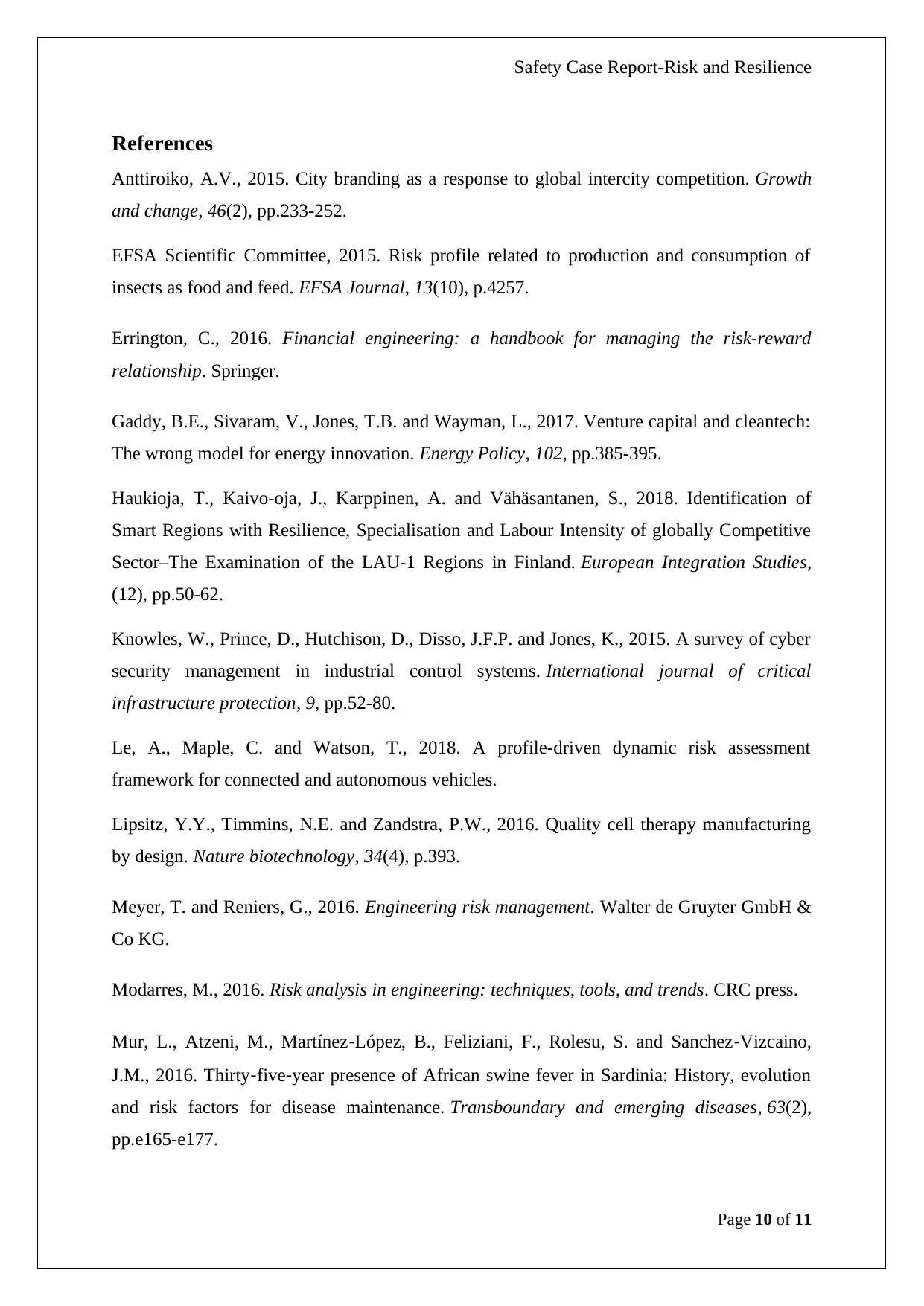
Safety Case Report-Risk and Resilience
References
Anttiroiko, A.V., 2015. City branding as a response to global intercity competition. Growth
and change, 46(2), pp.233-252.
EFSA Scientific Committee, 2015. Risk profile related to production and consumption of
insects as food and feed. EFSA Journal, 13(10), p.4257.
Errington, C., 2016. Financial engineering: a handbook for managing the risk-reward
relationship. Springer.
Gaddy, B.E., Sivaram, V., Jones, T.B. and Wayman, L., 2017. Venture capital and cleantech:
The wrong model for energy innovation. Energy Policy, 102, pp.385-395.
Haukioja, T., Kaivo-oja, J., Karppinen, A. and Vähäsantanen, S., 2018. Identification of
Smart Regions with Resilience, Specialisation and Labour Intensity of globally Competitive
Sector–The Examination of the LAU-1 Regions in Finland. European Integration Studies,
(12), pp.50-62.
Knowles, W., Prince, D., Hutchison, D., Disso, J.F.P. and Jones, K., 2015. A survey of cyber
security management in industrial control systems. International journal of critical
infrastructure protection, 9, pp.52-80.
Le, A., Maple, C. and Watson, T., 2018. A profile-driven dynamic risk assessment
framework for connected and autonomous vehicles.
Lipsitz, Y.Y., Timmins, N.E. and Zandstra, P.W., 2016. Quality cell therapy manufacturing
by design. Nature biotechnology, 34(4), p.393.
Meyer, T. and Reniers, G., 2016. Engineering risk management. Walter de Gruyter GmbH &
Co KG.
Modarres, M., 2016. Risk analysis in engineering: techniques, tools, and trends. CRC press.
Mur, L., Atzeni, M., Martínez‐López, B., Feliziani, F., Rolesu, S. and Sanchez‐Vizcaino,
J.M., 2016. Thirty‐five‐year presence of African swine fever in Sardinia: History, evolution
and risk factors for disease maintenance. Transboundary and emerging diseases, 63(2),
pp.e165-e177.
Page 10 of 11
References
Anttiroiko, A.V., 2015. City branding as a response to global intercity competition. Growth
and change, 46(2), pp.233-252.
EFSA Scientific Committee, 2015. Risk profile related to production and consumption of
insects as food and feed. EFSA Journal, 13(10), p.4257.
Errington, C., 2016. Financial engineering: a handbook for managing the risk-reward
relationship. Springer.
Gaddy, B.E., Sivaram, V., Jones, T.B. and Wayman, L., 2017. Venture capital and cleantech:
The wrong model for energy innovation. Energy Policy, 102, pp.385-395.
Haukioja, T., Kaivo-oja, J., Karppinen, A. and Vähäsantanen, S., 2018. Identification of
Smart Regions with Resilience, Specialisation and Labour Intensity of globally Competitive
Sector–The Examination of the LAU-1 Regions in Finland. European Integration Studies,
(12), pp.50-62.
Knowles, W., Prince, D., Hutchison, D., Disso, J.F.P. and Jones, K., 2015. A survey of cyber
security management in industrial control systems. International journal of critical
infrastructure protection, 9, pp.52-80.
Le, A., Maple, C. and Watson, T., 2018. A profile-driven dynamic risk assessment
framework for connected and autonomous vehicles.
Lipsitz, Y.Y., Timmins, N.E. and Zandstra, P.W., 2016. Quality cell therapy manufacturing
by design. Nature biotechnology, 34(4), p.393.
Meyer, T. and Reniers, G., 2016. Engineering risk management. Walter de Gruyter GmbH &
Co KG.
Modarres, M., 2016. Risk analysis in engineering: techniques, tools, and trends. CRC press.
Mur, L., Atzeni, M., Martínez‐López, B., Feliziani, F., Rolesu, S. and Sanchez‐Vizcaino,
J.M., 2016. Thirty‐five‐year presence of African swine fever in Sardinia: History, evolution
and risk factors for disease maintenance. Transboundary and emerging diseases, 63(2),
pp.e165-e177.
Page 10 of 11
Paraphrase This Document
Need a fresh take? Get an instant paraphrase of this document with our AI Paraphraser
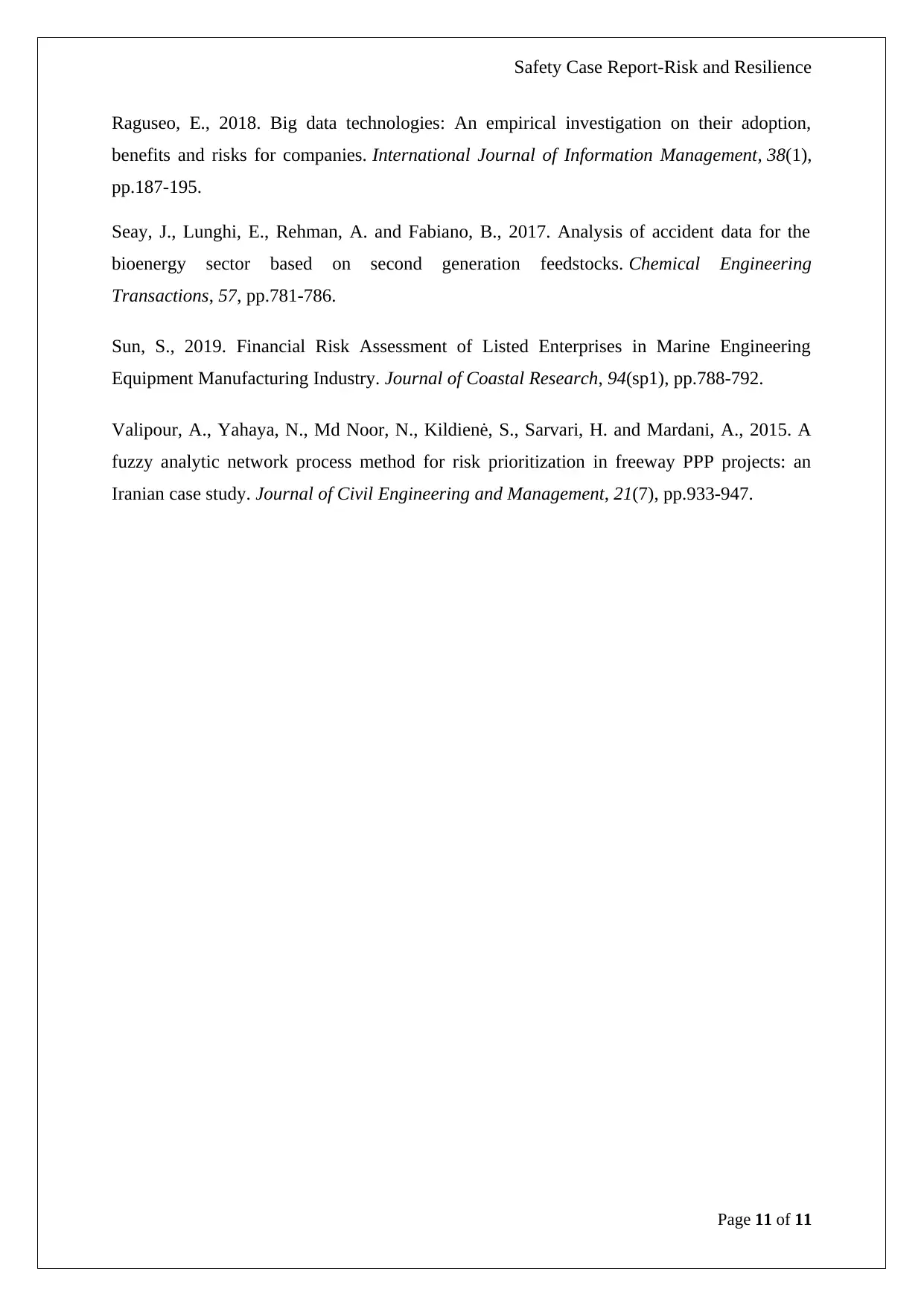
Safety Case Report-Risk and Resilience
Raguseo, E., 2018. Big data technologies: An empirical investigation on their adoption,
benefits and risks for companies. International Journal of Information Management, 38(1),
pp.187-195.
Seay, J., Lunghi, E., Rehman, A. and Fabiano, B., 2017. Analysis of accident data for the
bioenergy sector based on second generation feedstocks. Chemical Engineering
Transactions, 57, pp.781-786.
Sun, S., 2019. Financial Risk Assessment of Listed Enterprises in Marine Engineering
Equipment Manufacturing Industry. Journal of Coastal Research, 94(sp1), pp.788-792.
Valipour, A., Yahaya, N., Md Noor, N., Kildienė, S., Sarvari, H. and Mardani, A., 2015. A
fuzzy analytic network process method for risk prioritization in freeway PPP projects: an
Iranian case study. Journal of Civil Engineering and Management, 21(7), pp.933-947.
Page 11 of 11
Raguseo, E., 2018. Big data technologies: An empirical investigation on their adoption,
benefits and risks for companies. International Journal of Information Management, 38(1),
pp.187-195.
Seay, J., Lunghi, E., Rehman, A. and Fabiano, B., 2017. Analysis of accident data for the
bioenergy sector based on second generation feedstocks. Chemical Engineering
Transactions, 57, pp.781-786.
Sun, S., 2019. Financial Risk Assessment of Listed Enterprises in Marine Engineering
Equipment Manufacturing Industry. Journal of Coastal Research, 94(sp1), pp.788-792.
Valipour, A., Yahaya, N., Md Noor, N., Kildienė, S., Sarvari, H. and Mardani, A., 2015. A
fuzzy analytic network process method for risk prioritization in freeway PPP projects: an
Iranian case study. Journal of Civil Engineering and Management, 21(7), pp.933-947.
Page 11 of 11
1 out of 11
Related Documents
Your All-in-One AI-Powered Toolkit for Academic Success.
+13062052269
info@desklib.com
Available 24*7 on WhatsApp / Email
![[object Object]](/_next/static/media/star-bottom.7253800d.svg)
Unlock your academic potential
Copyright © 2020–2025 A2Z Services. All Rights Reserved. Developed and managed by ZUCOL.




